|
Related Target Drone
Pages:
Culver
Aircraft Corporation
Frankfort Sailplane Company
Montpelier Manufacturing
Company
Richter Manufacturing Company
Radioplane Company During World War Two
Van Nuys, CA
1939-1952 as Radioplane Company
1952-1957 as a Subsidiary of Northrop Aircraft, Inc.
1957-1972 as the Radioplane Division of Northrop Corporation
1972-at least until at least 1985 building drones as the Northrop
Ventura Division in Newbury Park, CA. This division still exists
but apparently no longer makes drones.
This page updated 6-26-2025.
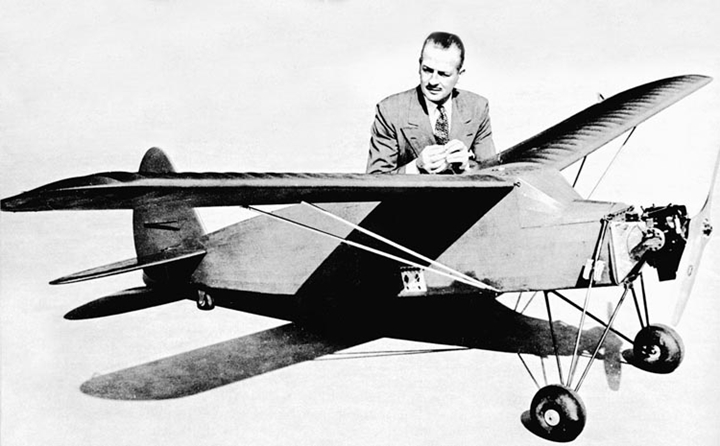
Shown in the photo above is Mr. Reginald
Denny with his 1935 RP-1 radio controlled drone. Mr. Denny had an
interesting background. One would not have thought he would have been
the inventor, along with several other persons, of the first radio
controlled aircraft used by the U.S. military. Born in Great
Britain in 1891, he served two years as an aerial
gunner with the Royal Flying Corps during World War One. He was
part of the rapid growth of aircraft for military purposes that
transpired during World War One. Prior to his service with the Royal Flying Corps, he sang
baritone with an opera troupe, and while in the service he became his
brigade's heavyweight boxing champion. He did it all.
After World War One, he moved to Hollywood, CA
to further his acting career and had many significant roles in movies of
the 1920s and 1930s. Reginald
Denny had a filmography of 187 acting credits from 1922 until his final
movie credits in two 1966 Batman movies. He also learned how to
fly and became interested in what were then the beginnings of the hobby
of radio controlled aircraft.
In the early 1930ís, Denny was between scenes on a movie set, when he
met a neighborhood boy trying to fly a bulky gas-powered model plane.
This meeting launched Dennyís infatuation with model aviation. Because
of his interest, he opened a model airplane shop on Hollywood Boulevard.
During this time, he was also in contact with military officers in the
area and learned that there was a need for an anti-aircraft target that
could maneuver and give more realistic training to the gunners.
The targets of the time were pulled behind aircraft.
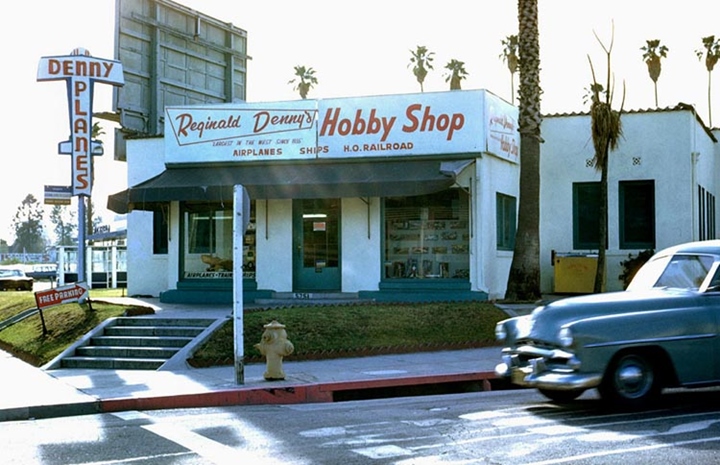
Reginald Denny's Hobby Shop was located at 5751 Hollywood
Blvd., Los Angeles, CA. This photo of the shop was taken in 1961.
Currently, there is a Harbor Freight store at this location.
In 1937 Mr. Denny sponsored a contest for the
best model airplane engine. The winner was Mr. Walter Righter.
Mr. Righter would eventually supply all of engines used in the
Radioplane World War Two drones. During this same time period, Mr. Denny
hired Mr. Kenneth Wallace Case, an engineer, to begin development
of the radio controlled drone. As the patent
2,257,277 shows below, these two men were the core engineering talent
who took ideas and made them into a usable product. Between 1937
and the beginning of World War Two, the company developed several
different prototype drones that were tested by the military. By
May 1939, the USAAF had tested and accepted the OQ-2A. Therefore, the Radioplane
Company was able to provide radio controlled drones in 1942 that could be used to train
anti-aircraft gunners. This was the company's model RP-5A.
Its U.S. Army designation was OQ-2A and its U.S. Navy designation was
TDD-1.
Patent 2,257,277:
Patent 2,257,277 shown below was an
important invention that allowed the Radioplane Company to safely
retrieve targets that had not been hit during anti-aircraft practice.
While it may seem counter intuitive that a target would need to be
safely brought back down to the ground, a good percentage of the time the
target was not hit during practice. Even if hit, the target in
many cases could be repaired and used again. Both the U.S. Army and the
U.S. Navy had learned before World War Two that hitting a moving
aircraft with anti-aircraft fire was more difficult than had been
expected.
While Reginald Denny and his partners had
developed a suitable radio-controlled target drone, getting back on the
ground safely with a very basic remote control flight system was
problematic and would result in the destruction of the drone.
Drones were expensive, as an OQ-2A in 1943 cost $1,195. This is
$21,640 in 2024 dollars. Also, this cost does not include the government
furnished equipment (GFE).
The basic idea of the invention is that once
the aerial target stopped receiving a radio signal, this would
automatically deploy the parachute, and the target would land without too much
damage and be able to be used again. This is the essence of the
almost four pages of detailed information in the patent.
Note that the inventors are Mr. Walter R.
Righter and Mr. Kenneth Wallace Case, the initial engineering core of
the fledgling Radioplane Company.
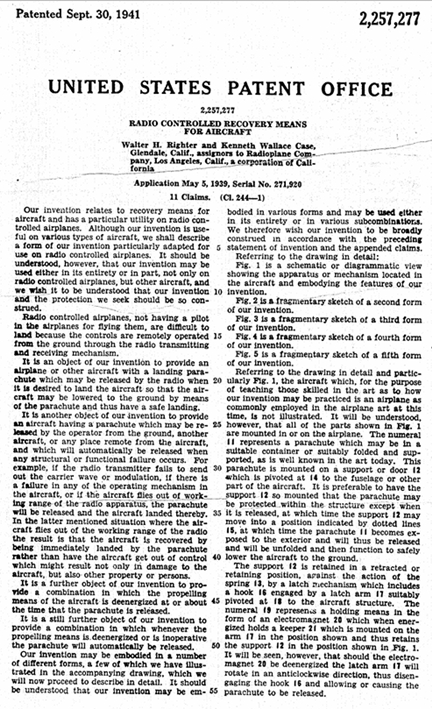
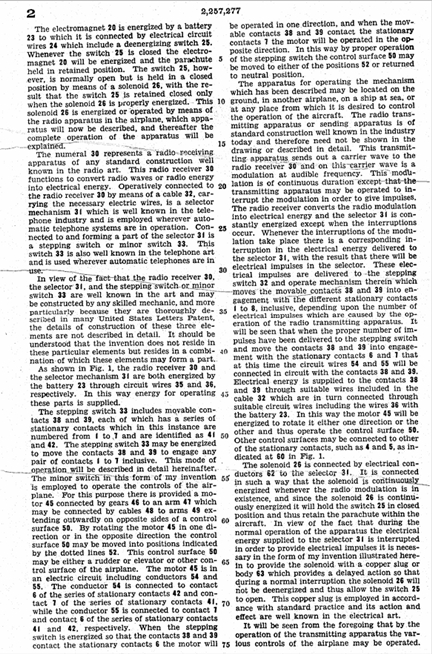
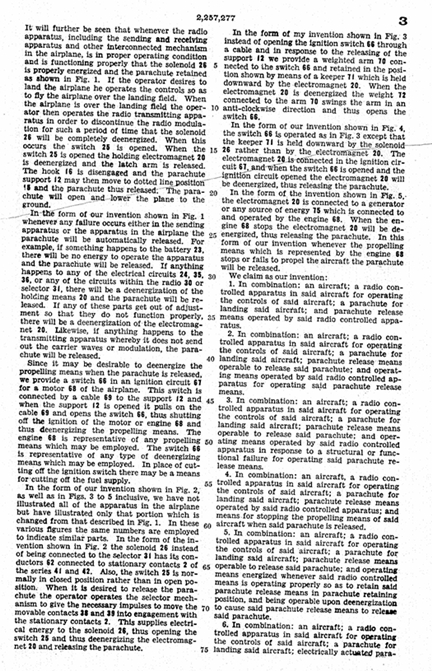
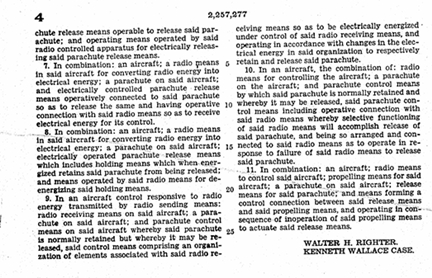
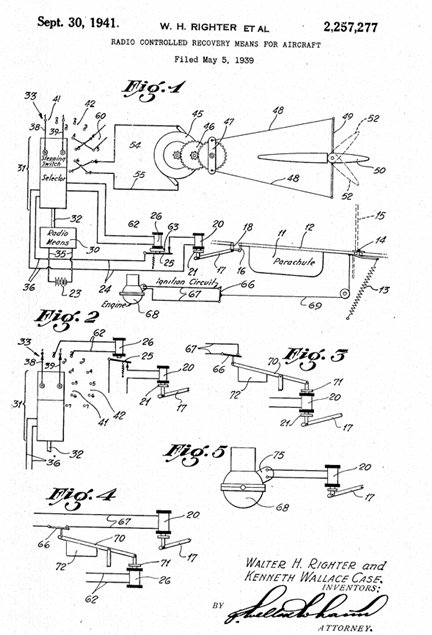
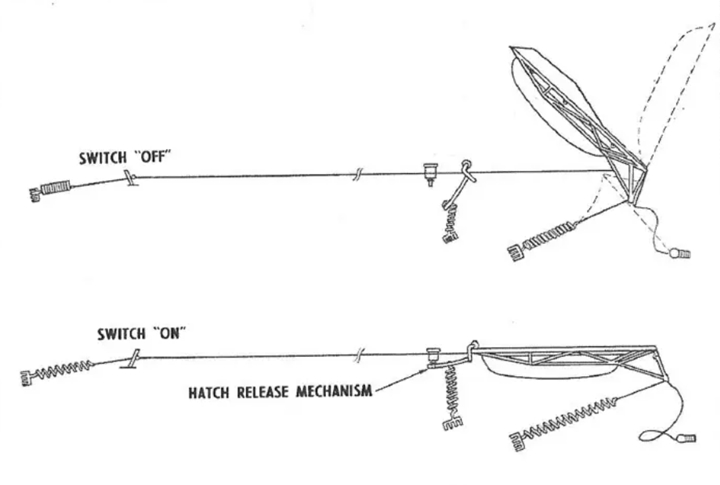
This is the OQ-3 parachute release system
and shows how the patent was applied in the Radioplane drones.
With no radio signal being received by the drone, the switch is off, and
the parachute door is open. With a radio signal being received by
the target, the door is closed.
This method of releasing the parachute was similar to the ones used on
the OQ-2A and the OQ-14 that was produced during World War Two.

All of the World War Two Radioplane aerial
target drones were launched from a catapult.
This photo shows an OQ-14 seated on the catapult. In the absence of a radio
signal, the engine ignition and solenoid latch to the parachute door are
disabled, allowing the parachute door to spring open.
Radioplane Company's
World War Two Products: Table 1 shows that the company had $20,381,000
in major contracts for aerial targets and parts from both the USAAF and
the U.S. Navy. Table 1 also shows that Radioplane Company produced
15,656
aerial targets to help win World War Two. Table 2 shows that the USAAF
received 70% of the targets and the U.S. Navy 30%.
Radioplane was not the only manufacturer of
its products. The Frankfort Sailplane Company (Globe Aircraft) was
also contracted by the USAAF and the Navy to produce the Radioplane
aerial targets under license. Table 4 shows the quantities of each
type of drone the two companies produced. A total of 25,712
Radioplane-designed aerial targets were produced between the two
companies to help win World War Two.
Table 1 - Radioplane Company's
Major and
Experimental World War
Two Contracts
The information below comes from the "Alphabetical Listing
of Major War Supply Contracts, June 1940 through September
1945." This was published by the Civilian Production
Administration, Industrial Statistics Division, Requirements
and Progress Branch January 21, 1946. |
|
Product - Customer |
Contract Number |
Contract Amount |
Number Built |
Award Date |
Completion
Date |
|
A-2 / OQ-2 |
N/A |
N/A |
53 |
N/A |
N/A |
| Aerial Targets - USAAF
(XOQ-2A) |
535-AC-18323 |
$77,000 |
25 |
4-1941 |
10-1941 |
| Targets - USAAF
(OQ-2A) |
535-AC-27027 |
$961,000 |
400 |
4-1942 |
7-1942 |
| Targets Aerial - USAAF
(OQ-2A) |
535-AC-30861 |
$7,193,000 |
2,060 |
7-1942 |
5-1943 |
| Aerial Targets - USAAF
(OQ-3) |
33038-AC-1744 |
$4,199,000 |
5,822 |
12-1943 |
9-1945 |
| Target
Parts OQ2A - USAAF |
33038-AC-1404 |
$205,000 |
N/A |
12-1943 |
1-1944 |
|
XOQ-5 |
N/A |
$25,000 |
1 |
1-1943 |
N/A |
|
XOQ-6 |
N/A |
N/A |
1 |
3-1943 |
N/A |
|
XOQ-7 |
N/A |
$10,000 |
4 |
12-1943 |
N/A |
|
XOQ-12 |
N/A |
N/A |
2 |
7-1941 |
N/A |
| Airplane Target Parts - USAAF |
33038-AC-5787 |
$74,000 |
N/A |
10-1944 |
1-1945 |
| Airplane Parts TDD2 - Navy |
288-XSA-26795 |
$171,000 |
N/A |
11-1944 |
1-1945 |
| Aerial Targets OQ14 - USAAF |
33038-AC-6314 |
$2,052,000 |
2,084 |
12-1944 |
7-1945 |
| Airplane Target Parts - USAAF |
33038-AC-7875 |
$70,000 |
N/A |
2-1945 |
5-1945 |
| Airplane Equipment - Navy |
288-XSA-30923 |
$50,000 |
N/A |
4-1945 |
12-1945 |
| Target Airplanes - Navy
(TDD-3) |
OA-6444 |
$2,477,000 |
3,120 |
4-1945 |
2-1946 |
| Aerial Target Assys - USAAF
(OQ14) |
33038-AC-9111 |
$1,086,000 |
500 |
5-1945 |
12-1945 |
| Target Airplanes - Navy
(TDD-3) |
OA-7254 |
$1,766,000 |
1,584 |
6-1945 |
4-1946 |
|
Total |
|
$20,381,000 |
15,656 |
|
|
|
Table 2 - Radioplane Company's
Aerial Target Production by Customer |
|
Customer
|
Quantity |
Percentage |
| USAAF |
11,052 |
70% |
| Navy |
4,704 |
30% |
| |
15,656 |
100% |
|
Table 3 - Radioplane Company's
World War Two Customers |
| Customer
|
Contract
Amount |
Percentage |
| USAAF |
$15,917,000 |
78% |
| Navy |
$4,464,000 |
22% |
| |
$20,381,000 |
100% |
Table 4 below shows the types and
quantities produced of aerial targets produced by the Radioplane Company
and Frankfort Sailplane Company.
|
Table 4 - Radioplane Company
and Frankfort Sailplane Company Production |
|
Model |
Radioplane |
Frankfort |
Total |
|
A-2 / OQ-2 |
53 |
0 |
53 |
|
XOQ-2A |
25 |
0 |
25 |
|
OQ-2A |
2,460 |
901 |
3,361 |
|
OQ-3 |
5,822 |
3,581 |
9,403 |
|
XOQ-5 |
1 |
0 |
1 |
|
XOQ-6 |
1 |
20 |
21 |
|
XOQ-7 |
4 |
0 |
4 |
|
XOQ-12 |
2 |
0 |
2 |
|
OQ14 |
2,584 |
2,164 |
4,748 |
|
TDD-3 |
4,704 |
3,390 |
8,094 |
| |
15,656 |
10,056 |
25,712 |
OQ-2A: Below are photos of an OQ-2A on display
at the Air Zoo Aerospace and Science Museum in Kalamazoo, MI.

Because the OQ-2A is hanging from the
ceiling, it allows for some different views of the target.
Interestingly enough, I have walked underneath this many times on my
visit to the Air Zoo but never noticed it. I made a special trip
to the museum in early November 2024 to see this. It took me
several minutes to find it as it is hiding in plain sight.
This display is in the restoration hangar, which was the original museum
building. Author's photo.
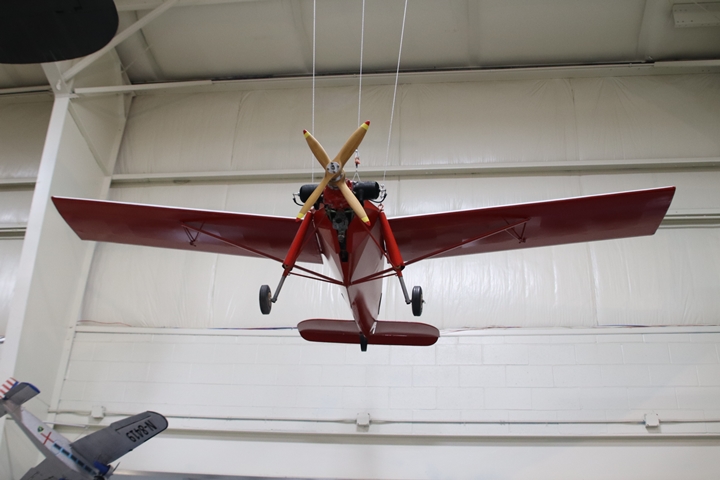
Author's photo.
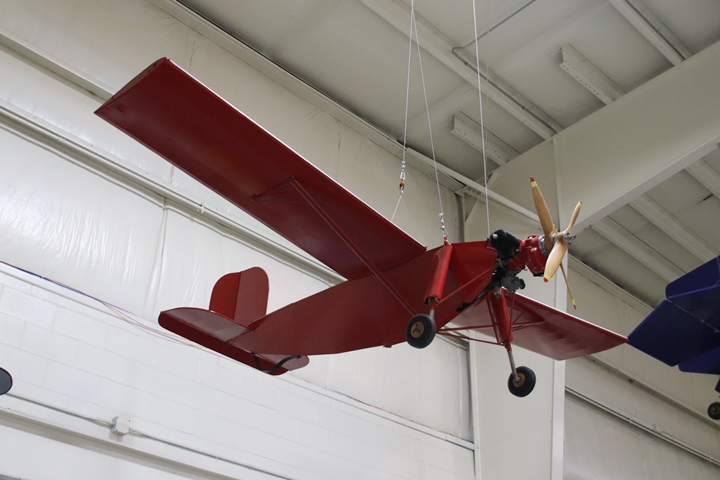
Author's photo.
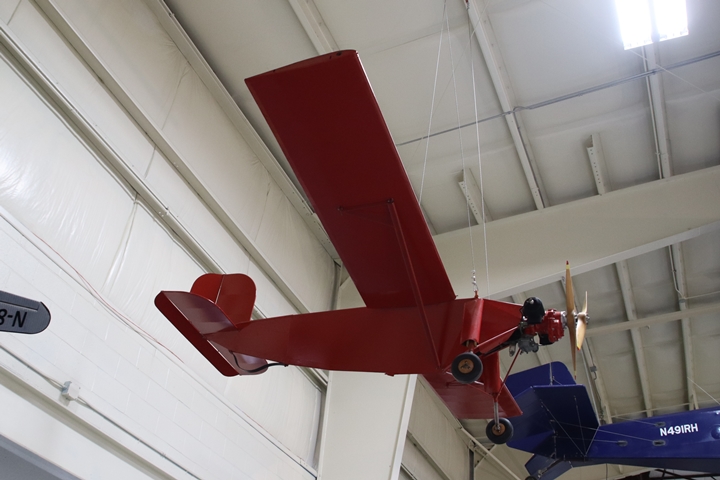
Author's photo.
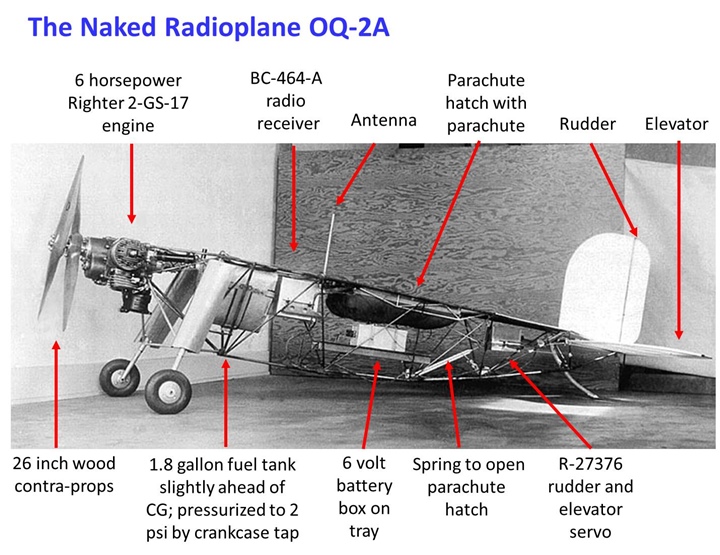
Image added courtesy of Tom Fey 6-26-2025.
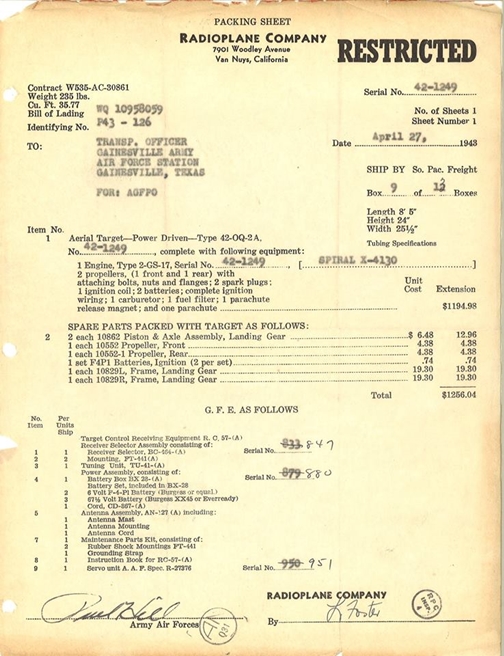
How cool is this? Mr. Kevin Russen has
been able to obtain a rare Radioplane packing sheet for the OQ-2A aerial
target. An examination of this document shows that there were
three different items or groups of items shipped. The first and
most obvious is the type OQ-2A, including accessories for $1,194.98.
For this price, this particular customer, the Gainesville Army Air Force
Station in Gainesville, TX, received a ready to fly aerial target.
Listed next are six spare part items for a cost of $61.06. The
last group on the document is the Government Furnished Equipment which
was the radio receiver and related items to control the target in flight.
Packing sheet courtesy of Mr. Kevin Russen via
Tom Fey.

Author's photo.

One of the distinct features of the OQ-2A
are the twin counter-rotating propellers. Author's photo.

Author's photo.

Author's photo.
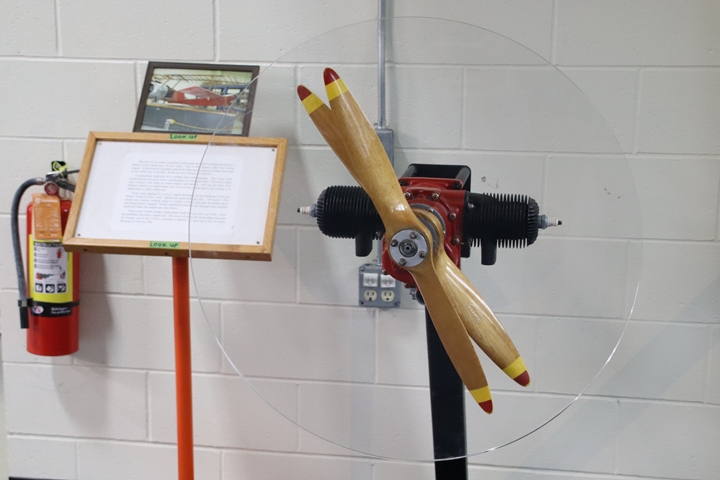
The museum also has a floor display of the
engine and propeller assembly. Author's photo.

Author's photo.

Author's photo.
OQ-2A: Below are photos of an
OQ-2A on display at the National Model Aviation Museum in Muncie, IN.
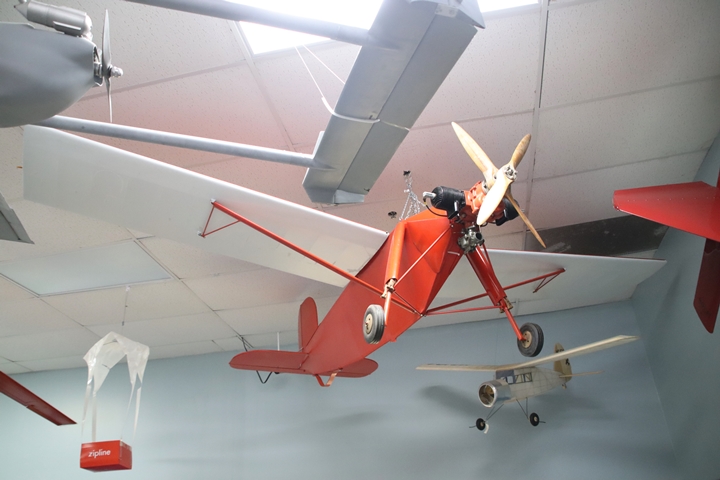
The museum's OQ-2A hangs from the ceiling
along with many other aircraft in the museum. The previous owners
of the OQ-2A were going to use the former World War Two target for
experimenting with a new control system. However, they later
decided against this idea and donated the target to the museum.
The former owners also incorrectly painted the underside of the wings
white, as shown here. They should have painted the top of the
wings white. Author's photo added 6-26-2025.
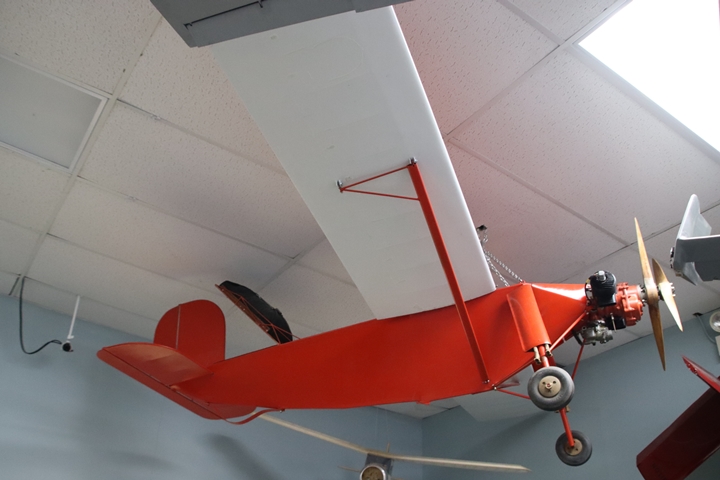
Note that in this photo the parachute door
is open. It is not open in the previous image. During my
visit to the museum, Mr. Michael Smith, Director of the Museum, spent a
considerable amount of time with me explaining not only the history of
the Radioplane OQ-2A, but several other displays in the museum. At
some point in the conversation, he noted that the parachute was still in
the target, and then offered to open the parachute door for me. He
then obtained the scaffold the museum uses to attach models to the
ceiling and proceeded to climb onto the scaffold and open the parachute
door. Author's photo added 6-26-2025.
Using my camera, Mr. Smith then took the
following photos.
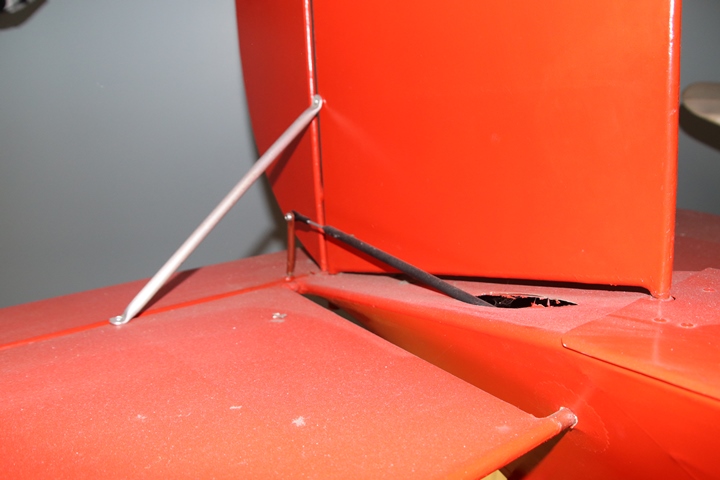
This shows the connecting rod that attaches
the Hansen Manufacturing Company servo located in the rear of the target
to the elevator. Note that the rear of the fuselage angles down
towards the rear of the aircraft from the main fuselage. The
vertical stabilizer also has a brace on each side to hold it in place.
The one on the starboard side of the target can be seen here.
Michael Smith photo added 6-26-2025.
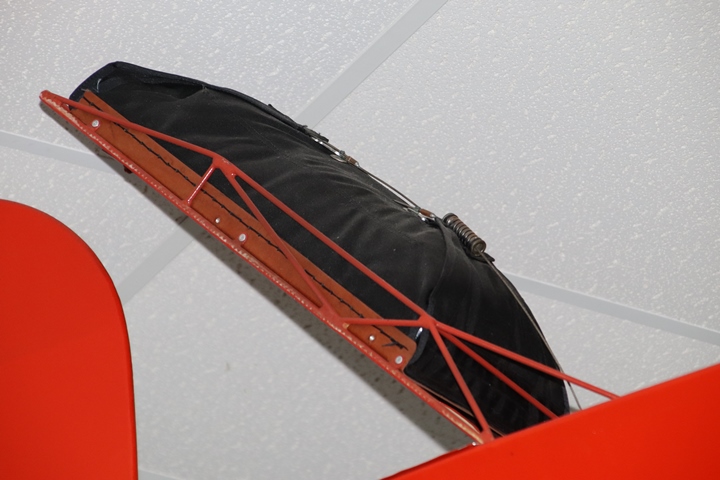
This and the next four photos show the
parachute and door mechanism. Michael Smith photo added 6-26-2025.
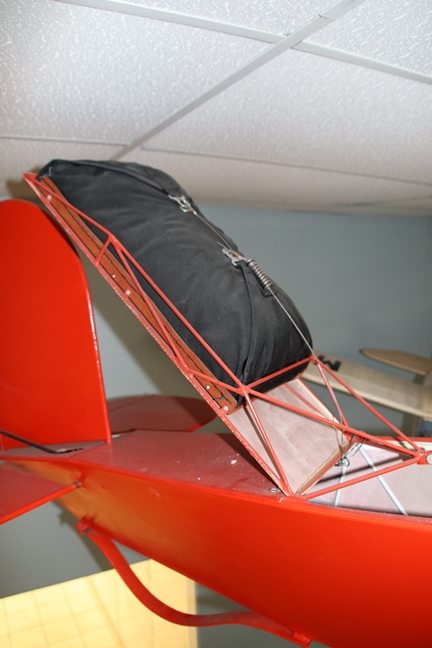
Besides the parachute and its door, the
elevator control arm can be seen in this photo. Michael Smith
photo added 6-26-2025.
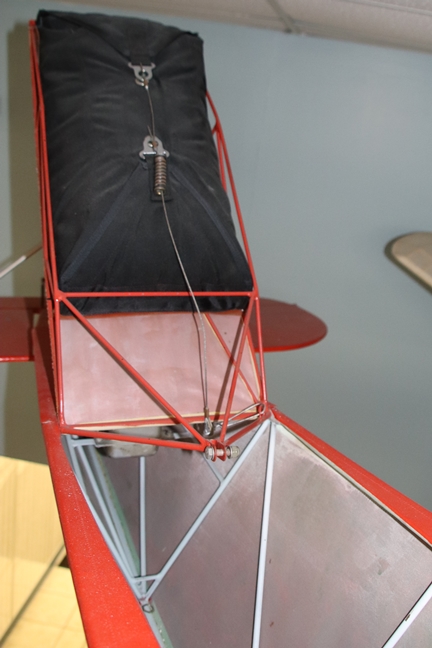
This photo also shows a portion of the steel
rod framing. Michael Smith photo added 6-26-2025.
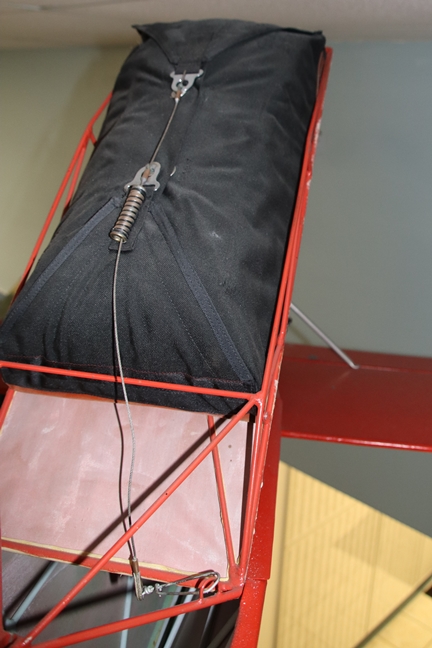
Michael Smith photo added 6-26-2025.
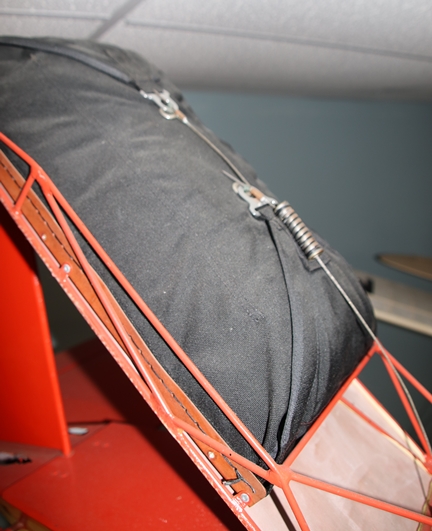
Michael Smith photo added 6-26-2025.
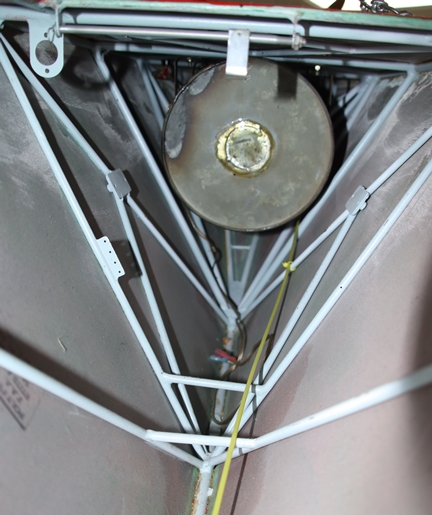
This photo shows the fuel tank in the front
of the target. The radio receiver that would be mounted behind it
has been removed. However, two mounting tabs for it can be seen on
the left and at the top of the framework. Michael Smith photo
added 6-26-2025.
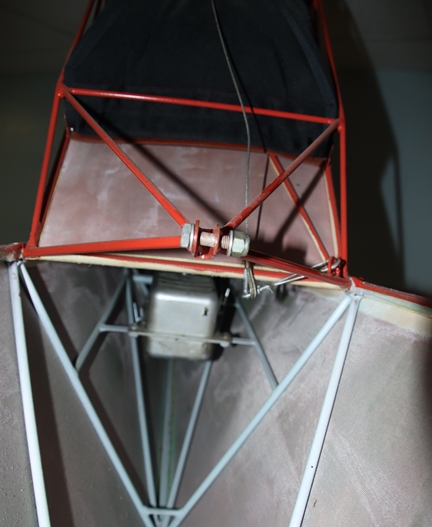
This photo shows the servo unit in the rear
of the aircraft built by the Hansen Manufacturing Company, Princeton,
IN. This unit is Hansen part number 27376. Michael Smith
photo added 6-26-2025.
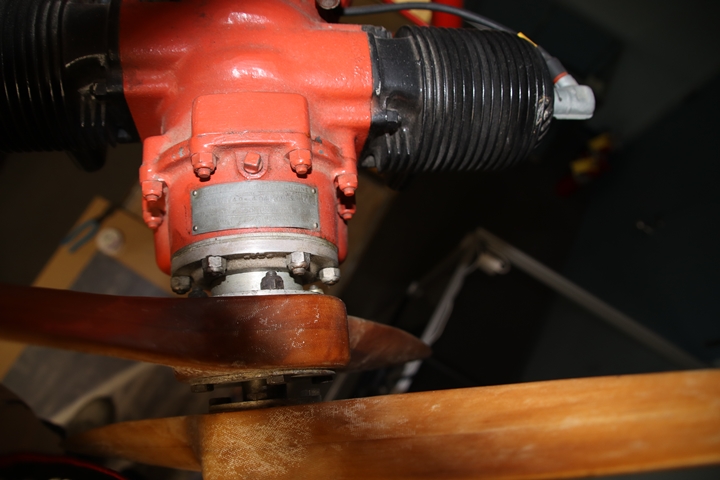
Mr. Smith
also photographed the Righter Manufacturing Company 0-15-1
engine in order to obtain the information from the data
plate. Michael Smith photo
added 6-26-2025.
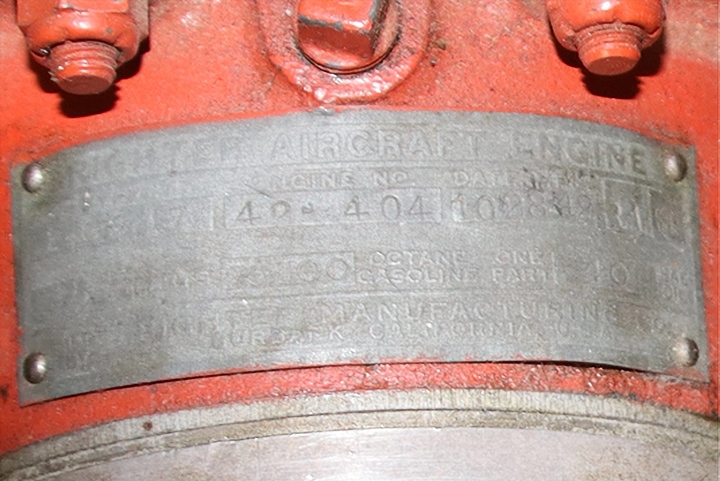
This is engine serial number 42-404 with a
date of 10-28-42. The serial number and date imply that Righter
had built 449 engines up through the 28th of October in 1942.
Michael Smith photo added 6-26-2025.
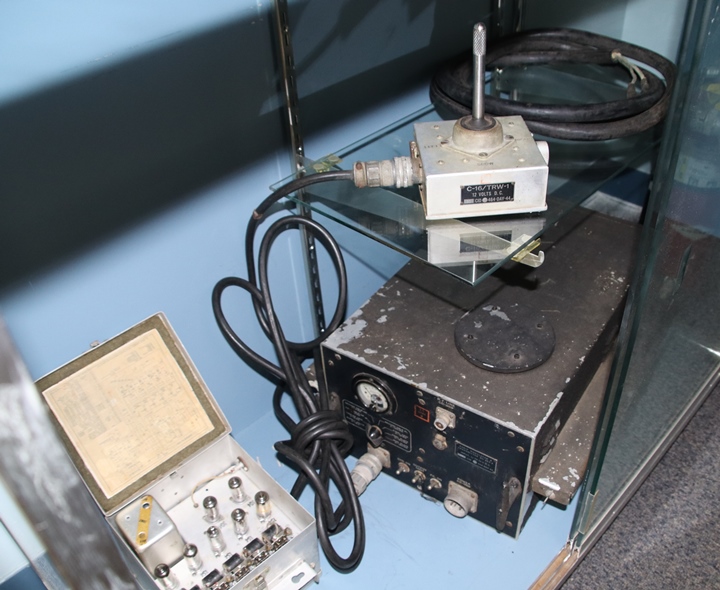
The
National Model Aviation Museum also has the
transmitter, joystick, and radio receiver on display for the Radioplane
OQ-2A. Author's photo added 6-26-2025.
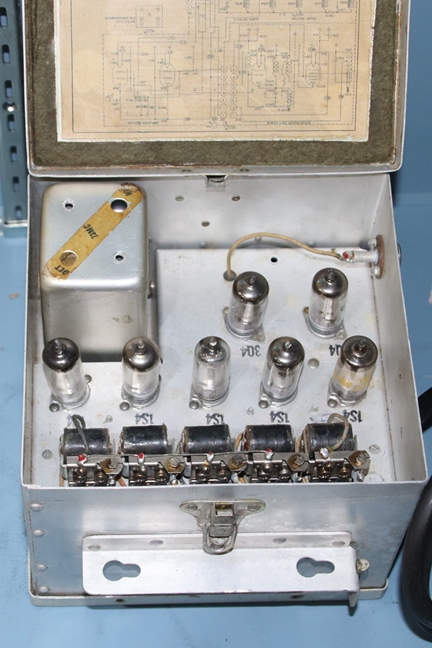
This is the BC-464A receiver that mounted
behind the fuel tank in the target. There are five tubes that
match five solenoids. Four of each controlled the up, down, right,
left movements of the aircraft. The fifth one controlled the
engine off-on function. Author's photo added 6-26-2025.
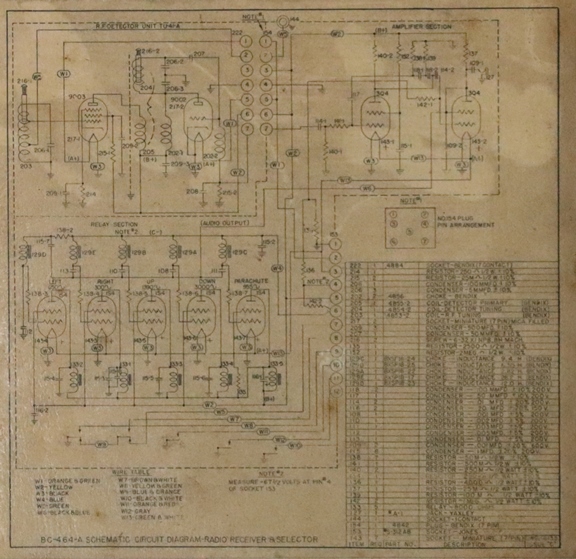
This is the wiring diagram for the BC-464A.
Author's photo added 6-26-2025.
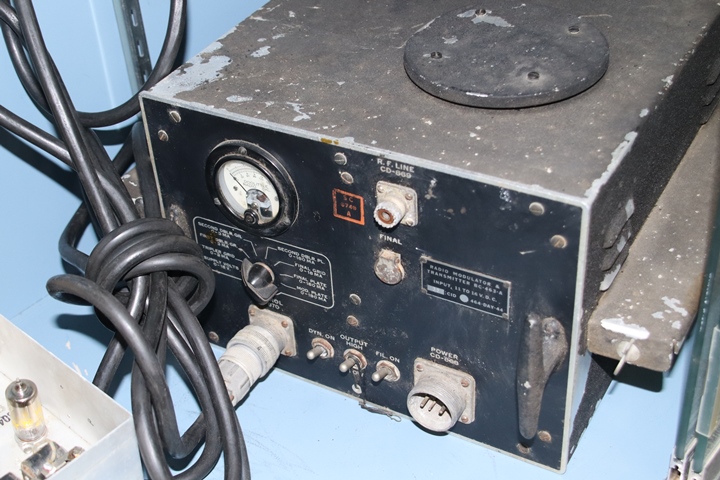
The transmitter for controlling the OQ-2A
was the BC-463-A. Author's photo added 6-26-2025.
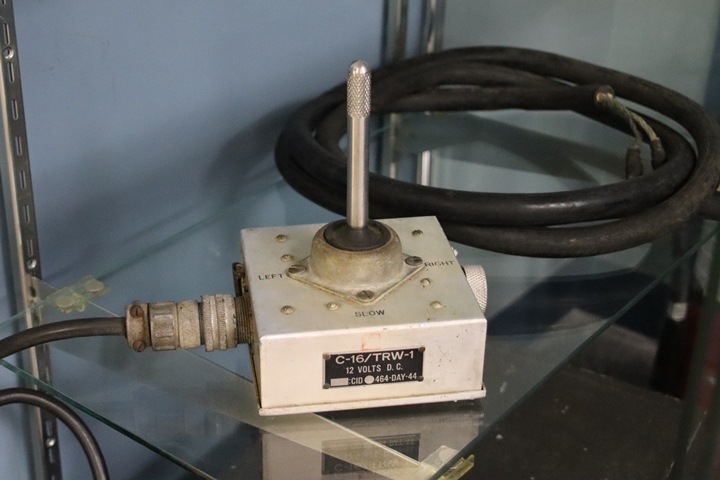
This joystick is similar to the one
required to control the Radioplane target drones but is not the correct
unit. Note that the C-16/TRW-1 show here is marked "slow" in its
bottom position This particular joystick is either for a land or water
remote controlled vehicle where the speed could be changed. The
Radioplane target drones were all constant speed units. The
correct joystick is a.BC-462-TC or BC-462-A. See below.
Author's photo added 6-26-2025.
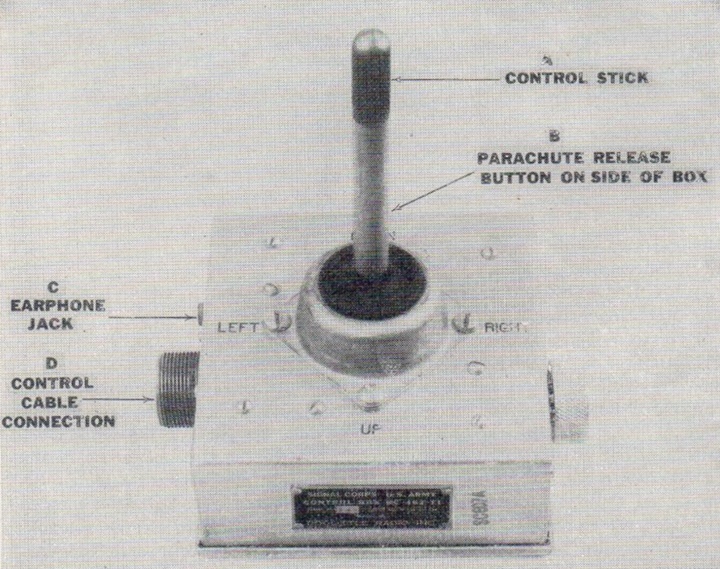
This is the correct joystick where control
of the unit is left and right, and up and down. There is also a
button on the side of the control box to release the parachute by
shutting off the engine. Image added courtesy of Tom Fey
6-26-2025.
OQ-2A: Below are photos of an
OQ-2A on display at the MAPS Air Museum in North Canton, OH.
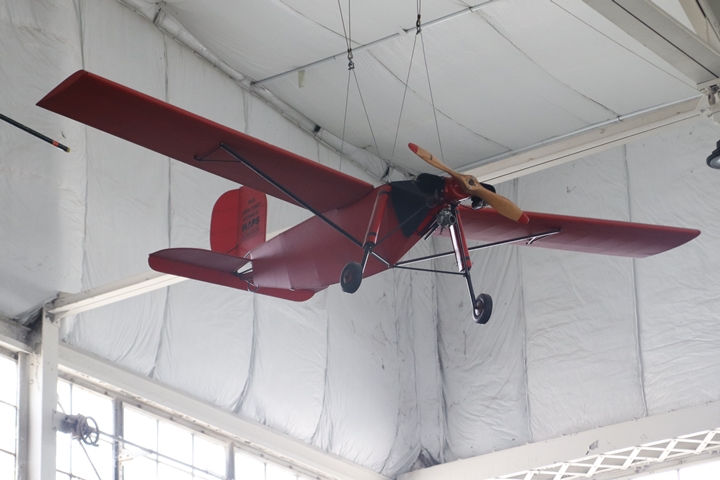
This example is hanging from the ceiling in
the museum's hangar. It should be noted that while this can be
identified as an OQ-2A due to the landing gear, the engine is
a Righter
0-15-3
from an OQ-3. From the previous photos we have seen that the OA-2A
has the two counter-rotating propellers. Author's photo added
6-26-2025.
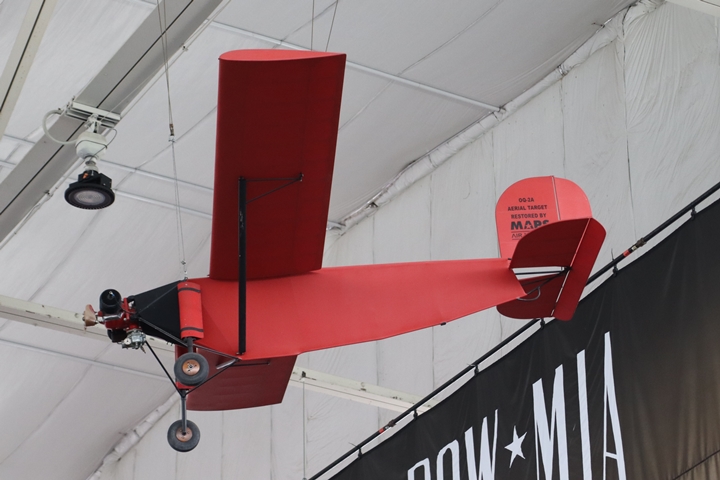
The museum's hanger does have a balcony on
the second floor which allows for this and the following photos.
Note that the restoration of the OQ-2A did not include the fabric cover
of the section under the rear control surfaces. Author's photo
added 6-26-2025.
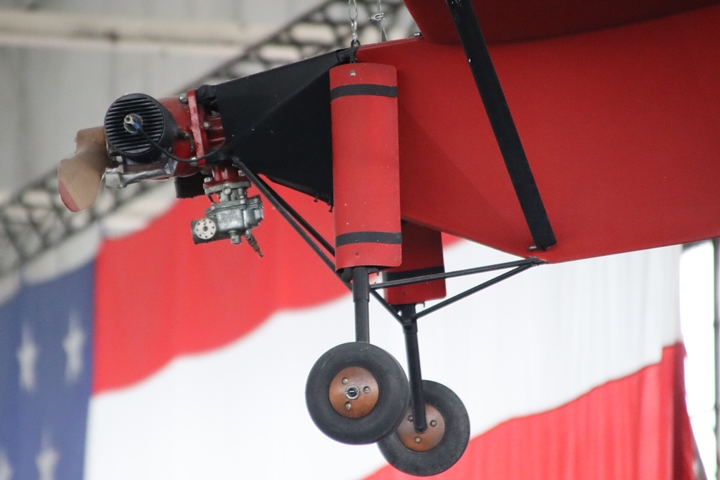
Author's photo added 6-26-2025.
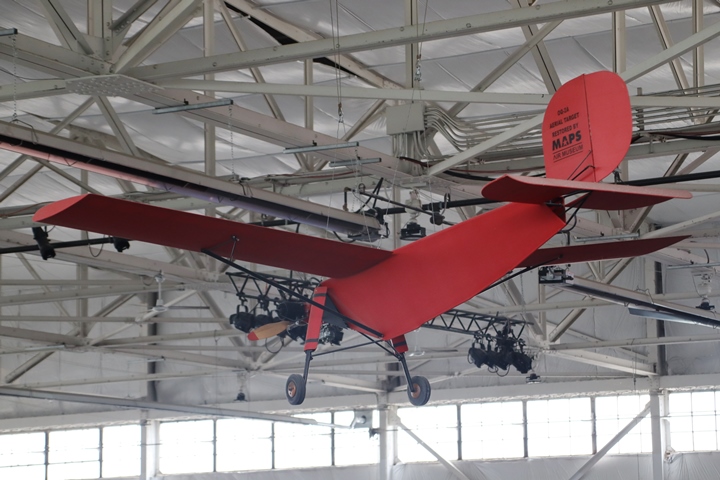
Author's photo added 6-26-2025.
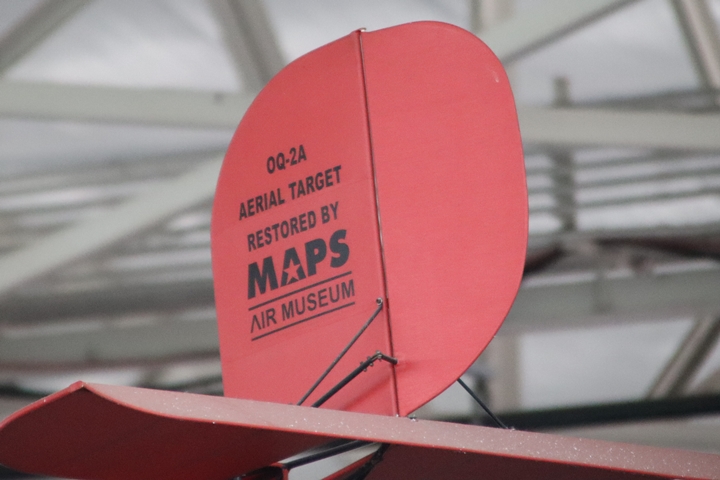
This image shows the port side vertical
stabilizer brace, and the control arm for the rudder. Author's
photo added 6-26-2025.
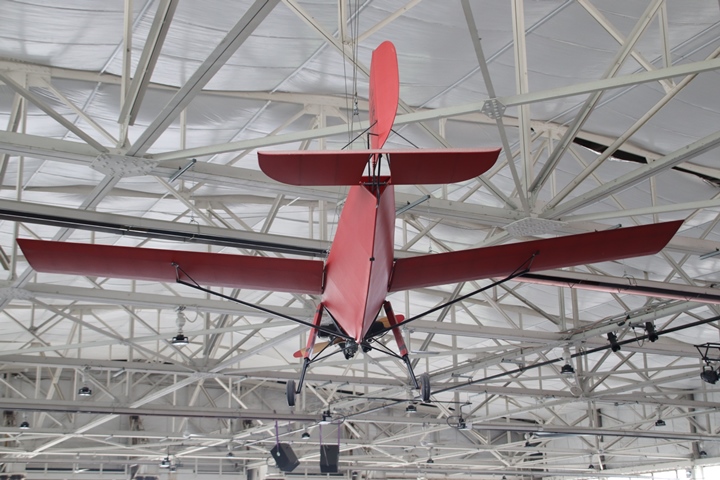
Author's photo added 6-26-2025.
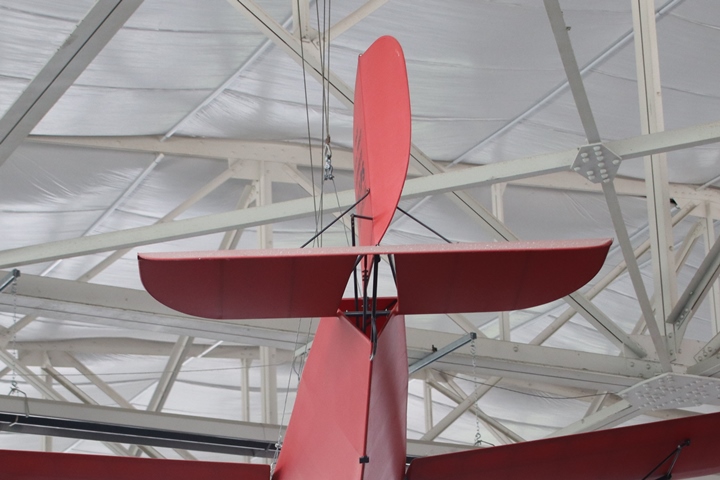
This view shows both vertical stabilizer
braces and the rudder control. Author's photo added 6-26-2025.
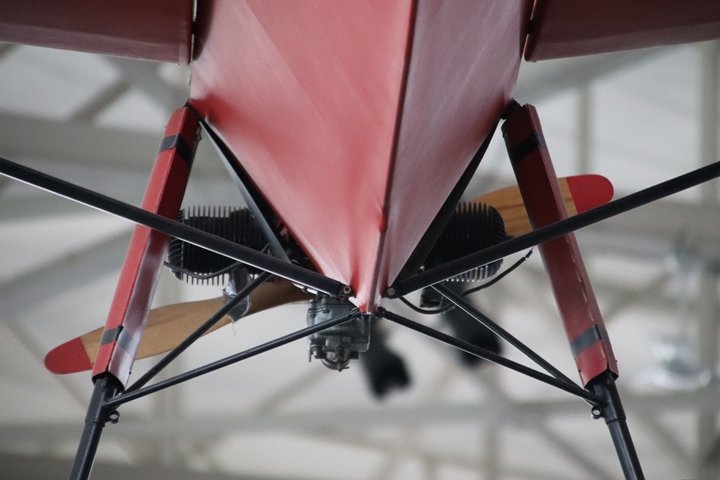
Author's photo added 6-26-2025.
OQ-3:
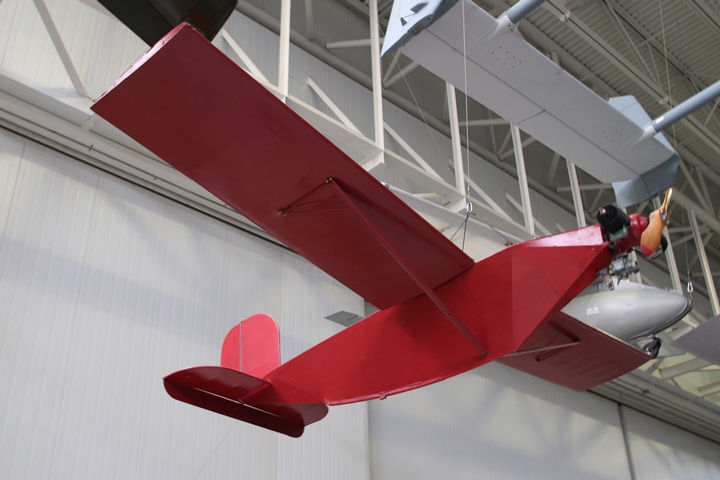
This
Radioplane OQ-3 is on display at the Army Aviation Museum at Fort Novosel,
AL. The engine in the OQ-3 used a 30 inch diameter single-rotation
propeller. Author's photo.
Below are several pages from "Radio-Controlled
Airplane Target - AAF Type OQ-3 Navy Model TDD-2."
The systems shown were similar to the OQ-2A and OQ-3 that Radioplane built during
World War Two.
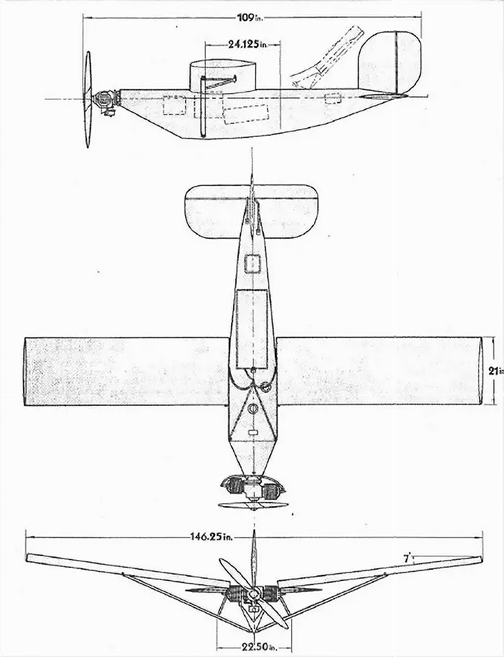
The dotted line drawing is the open door
position for the parachute. This application would be similar on
all of the models Radioplane built during World War Two.
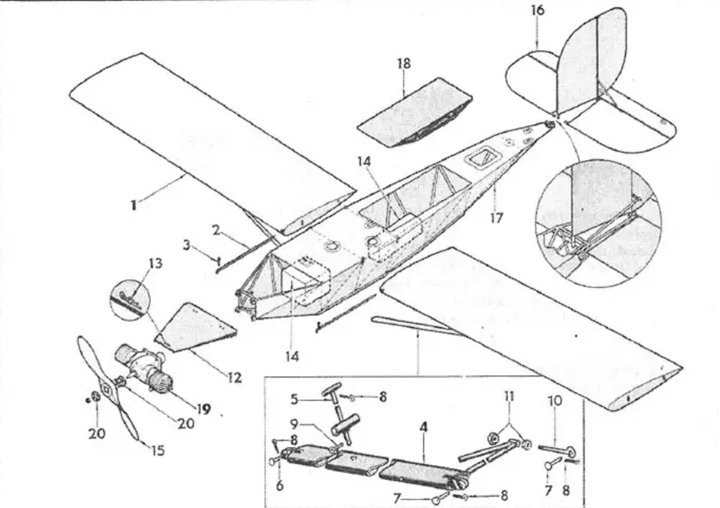
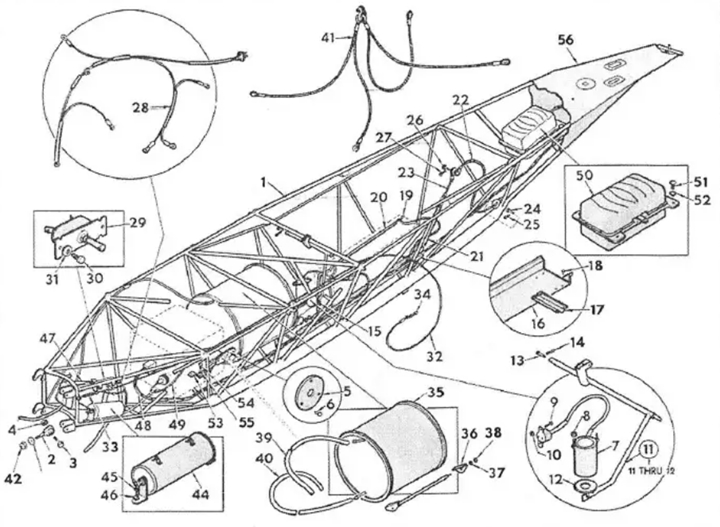
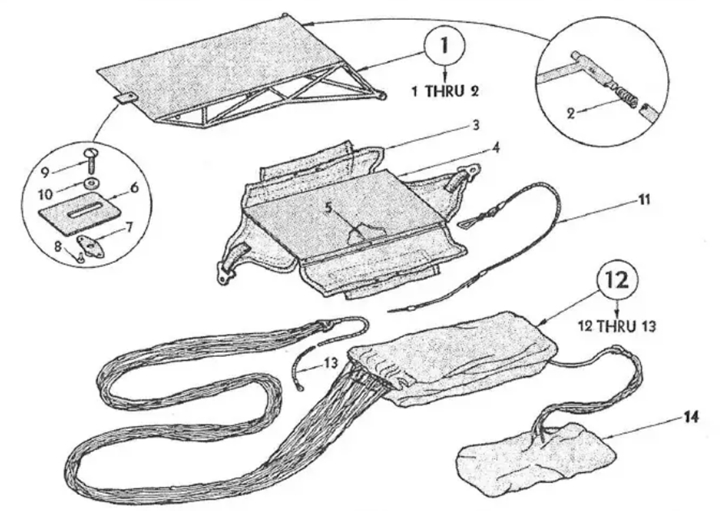
This image shows the components of the
parachute assembly. From the top down, there is the door, the
parachute container, the main parachute, and the drogue parachute.
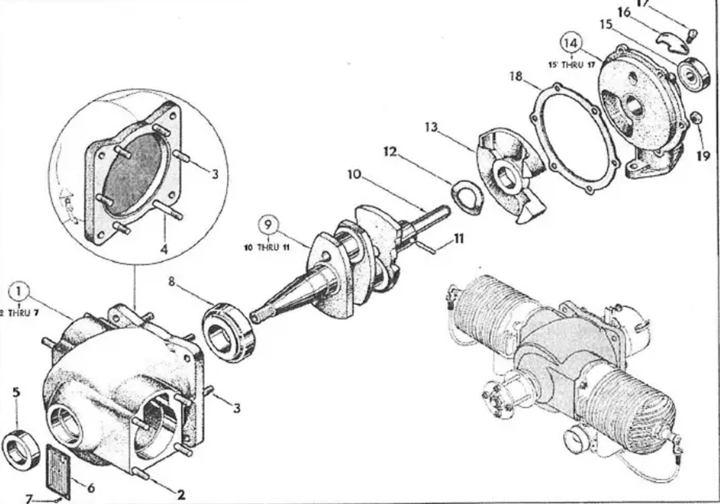
The next three images show the various
components that went into the Righter O-15-3 engine.
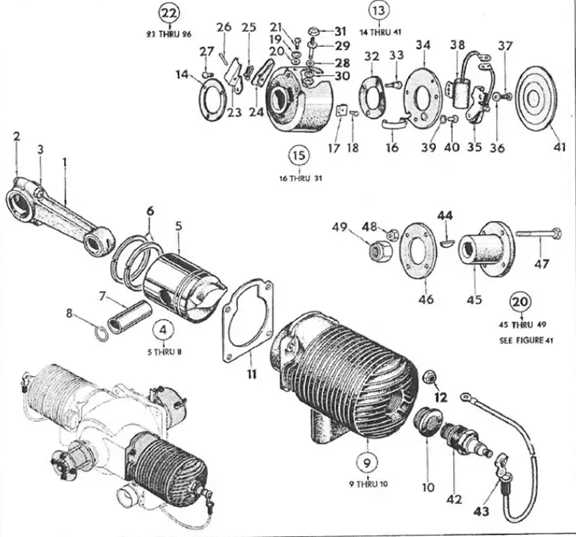
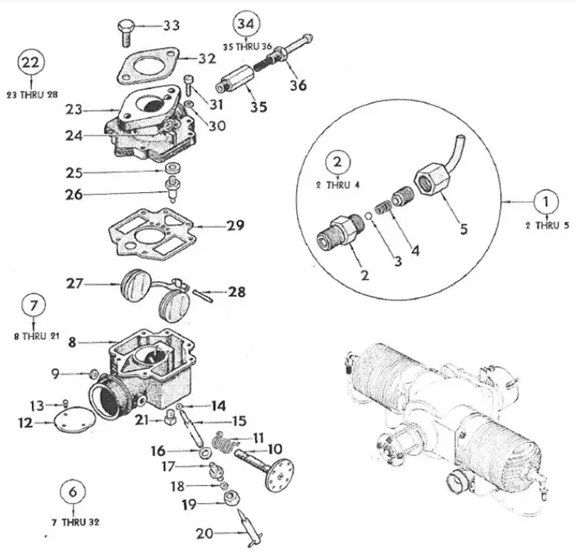
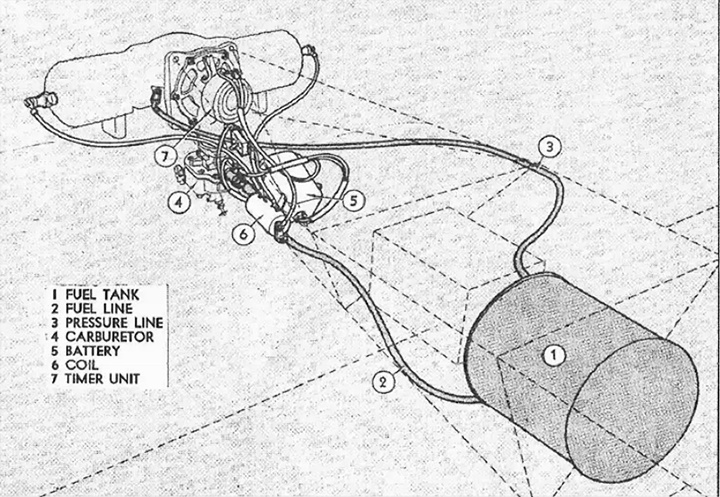
This image shows the fuel and electrical
system for the Righter O-15-3 engine.
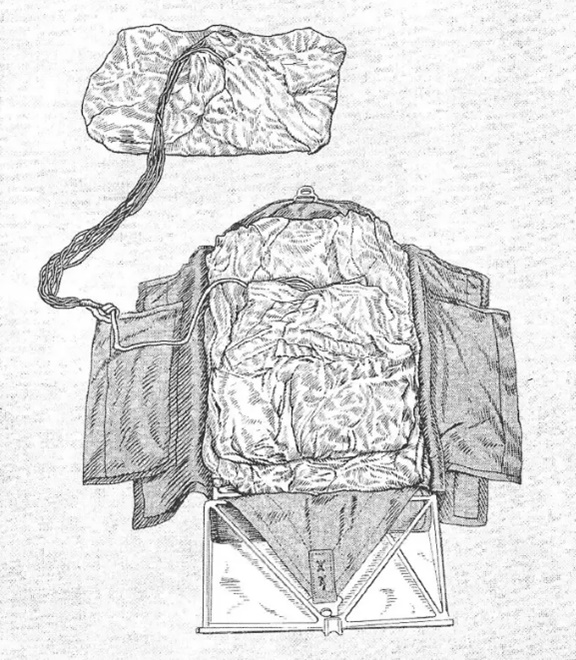
This image shows the drogue chute and the main
chute in the outer packing.
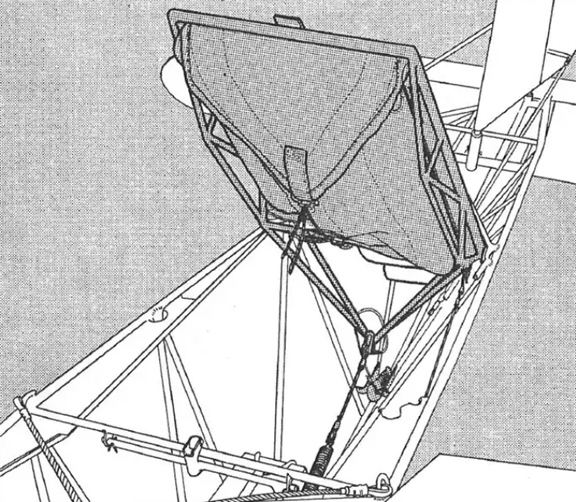
This image shows the parachute door
assembly.

This is the OQ-3 parachute release system
and shows how the patent was applied in the Radioplane drones.
With no radio signal being received by the drone, the switch is off, and
the parachute door is open. With a radio signal being received by
the target, the door is closed.
OQ-14: The Radioplane OQ-14 shown
below is on display at the National Museum of the United States Air
Force.

The OQ-14 was similar in exterior
configuration to the OQ-3. It had a larger Righter O-45-1 20 hp
engine that allowed the OQ-14 to fly at 140 mph. Author's photo.
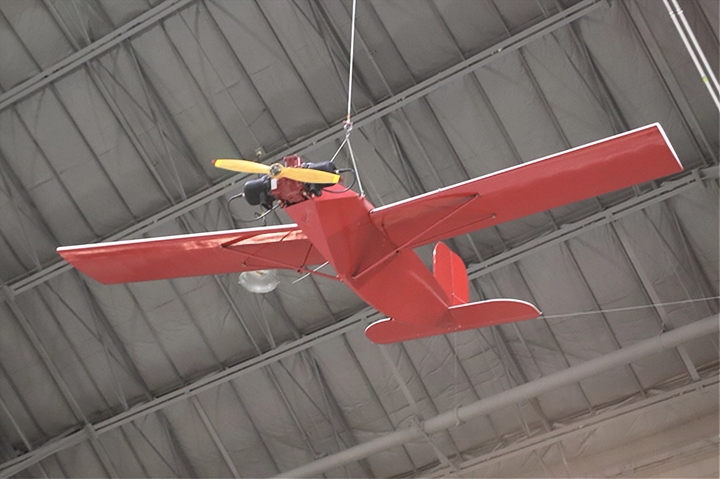
Author's photo.
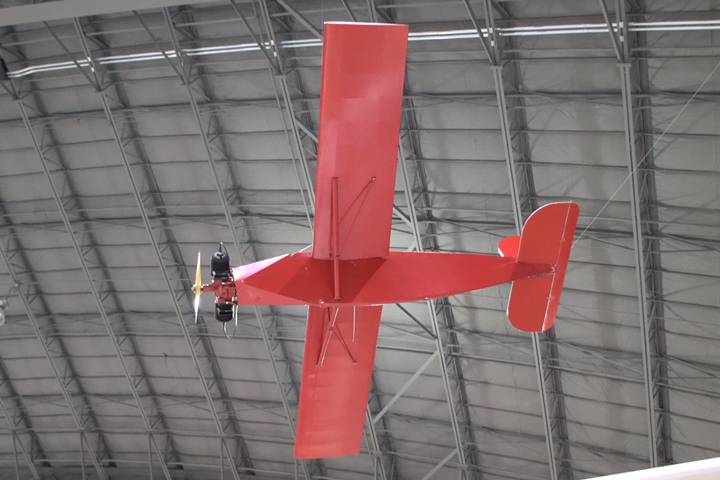
Author's photo.
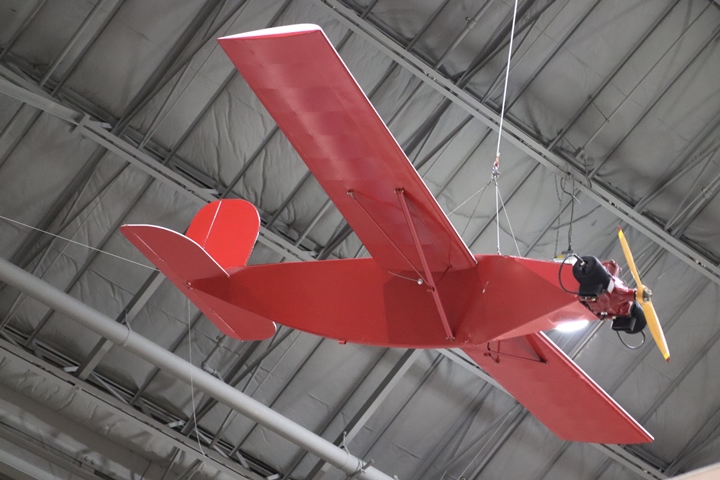
Author's photo.
Post World War Two Radioplane/Northrop
Aerial Targets:
OQ-19D: Work on the OQ-19 began
in 1945 and production commenced in 1946. With over 10,000 being
built, this was the main aerial target used by the military immediately
after World War Two. It was used in the early jet aircraft era.
There were actually four different production designs of the OQ-19.
The D model was the last and the fastest of the series. The one
shown below is on display at the National Museum of the United States
Air Force.
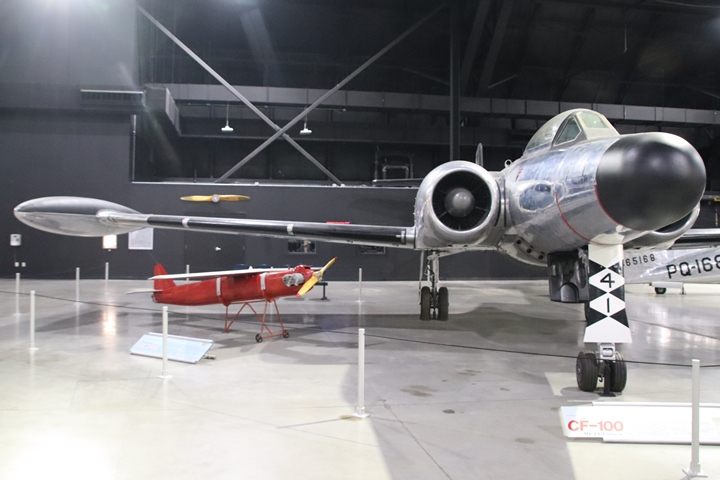
The OQ-19 is three feet longer than the
previous OQ-14, and its over twelve foot length takes up a good amount of
the CF-100 wing. Author's photo.
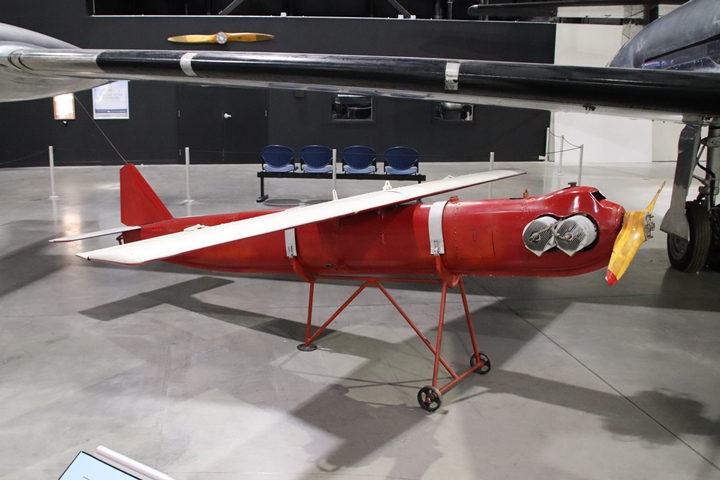
Author's photo.
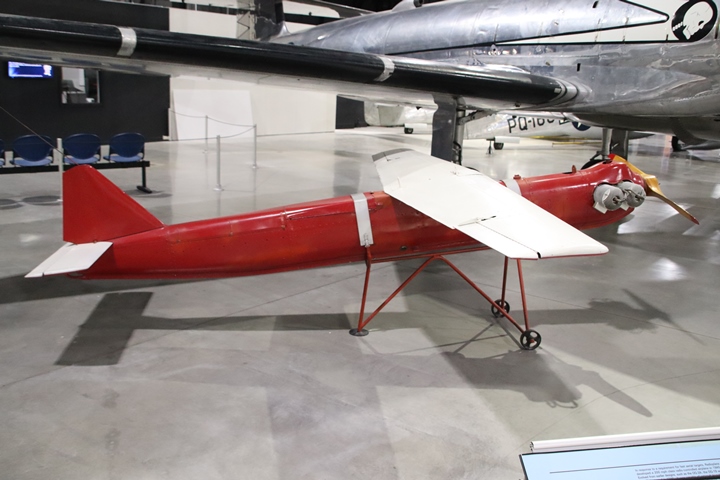
Author's photo.
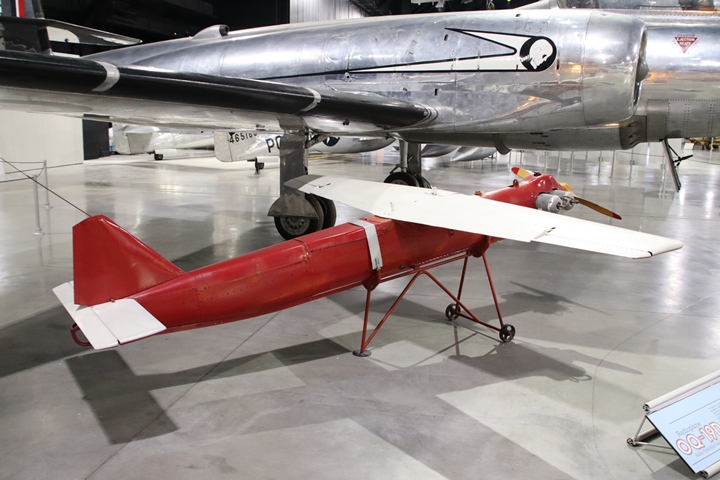
Author's photo.
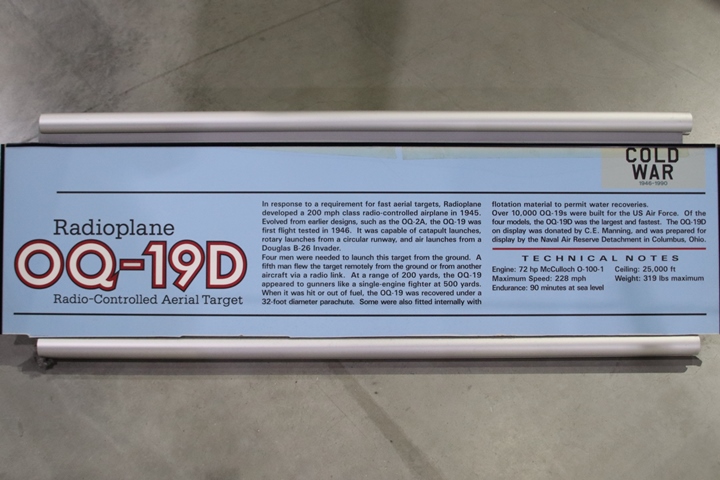
Author's photo.
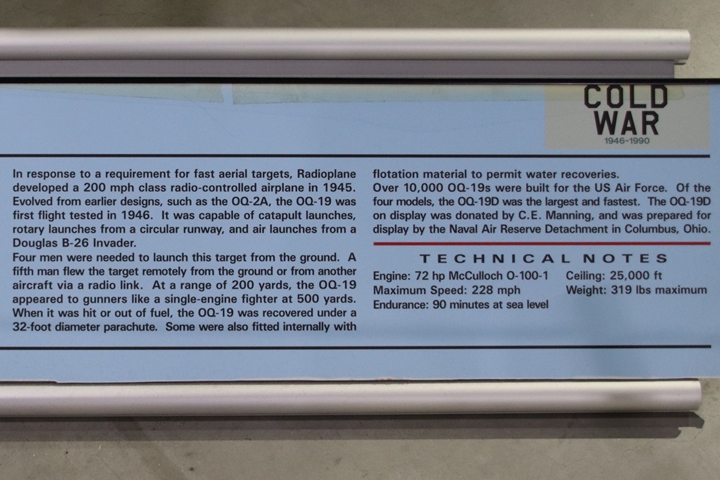
Note that it took four men to move this
aerial target on the ground.
Author's photo.
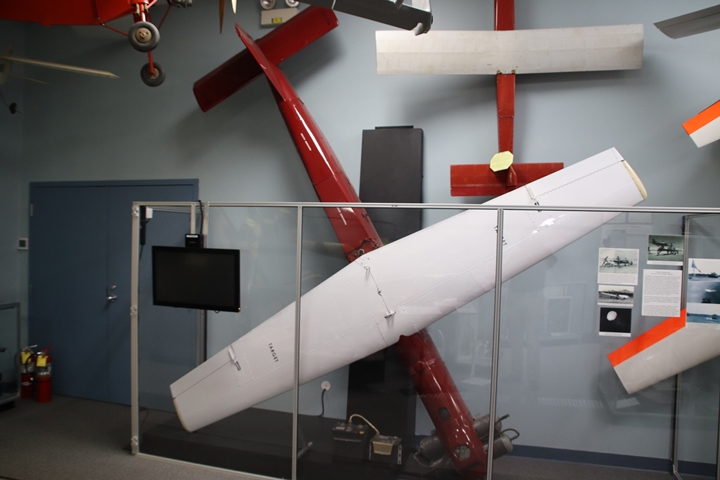
The
National Model Aviation Museum in Muncie, IN
has this OQ-19 on display. It is either a B or D model, the only
difference being that the B model had an internal gyroscope that allowed
for limited out of line-of-sight flying. Author's photo added
6-26-2025.
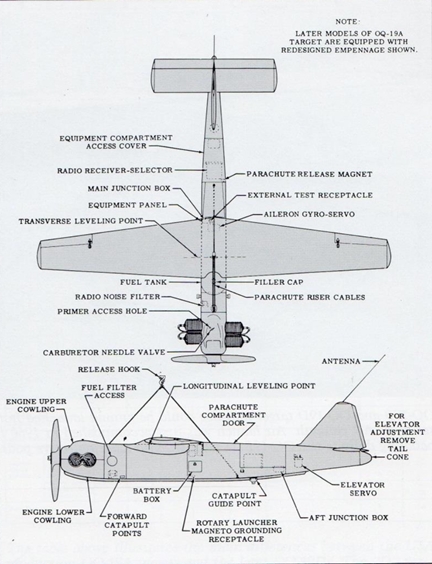
Image added courtesy of Tom Fey 6-26-2025.
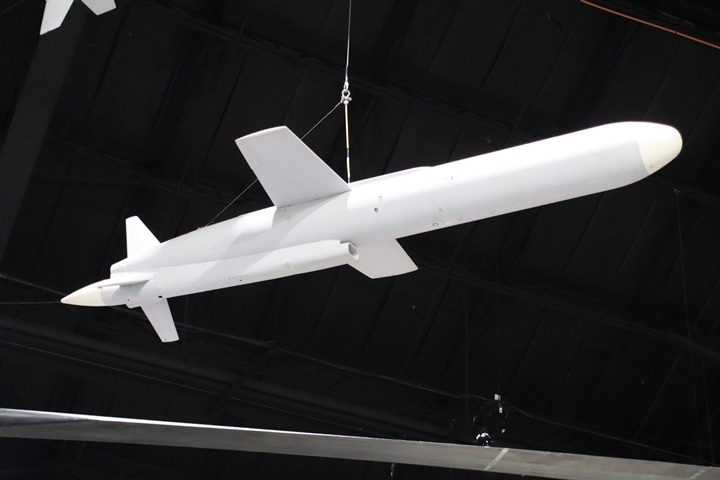
Northrop purchased Radioplane in 1952 and
continued to produce aerial targets into the 1980s. This Northrop
BQM-74C was a U.S. Navy target that was designed in 1978. This
example is on display in the National Museum of the United States Air
Force, because during Operation Desert Storm, the United States Air Force
modified 44 units as decoys.
Author's photo.
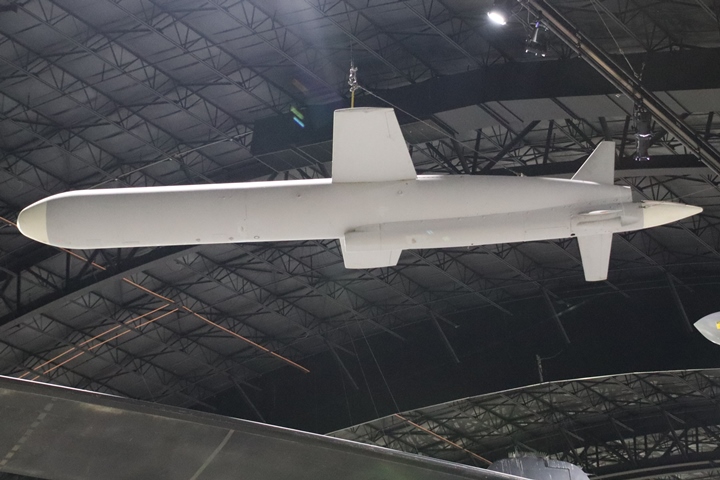
Author's photo.
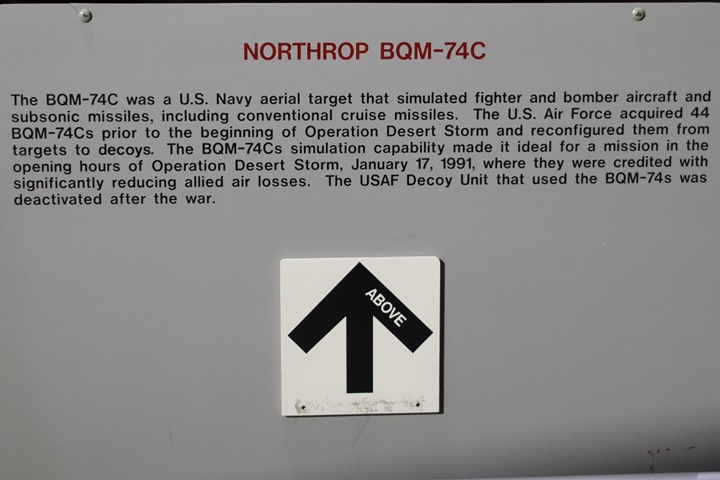
Author's photo.
The Radioplane Company Plants:
The bill of sale shown earlier on this page indicates the company's
address during World War Two was 7901 Woodley Avenue in Van Nuys, CA.
There is still a factory located at this address. However, this is
not the same factory complex used by Radioplane during World War Two.
After World War Two, Radioplane moved into a larger plant at 8000 Woodley
Avenue.
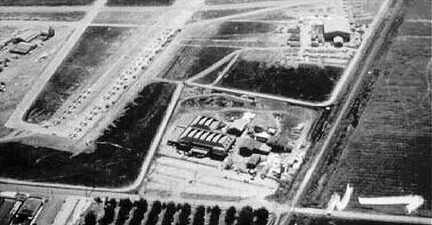
This 1946 image shows the Radioplane Company
plant at 7901 Woodley Avenue in Van Nuys, CA. This is the complex
of several buildings along the road at the bottom of the photo.
Radioplane moved into this facility in March 1942 from its original
plant in Venice, CA. With production ramping up, it needed more
factory space. This was formerly the location of the Timm Aircraft
Corporation. Timm took the plant over from Kinner Airplane and
Motor Company when it went bankrupt in the late 1930s. Timm moved
to the west side of the field in March 1942.
This large hangar in the upper right of the
photo is the Lockheed P-80 Production Flight Test Hangar. The
aircraft on the ramp in the center of the photos are P-80s.
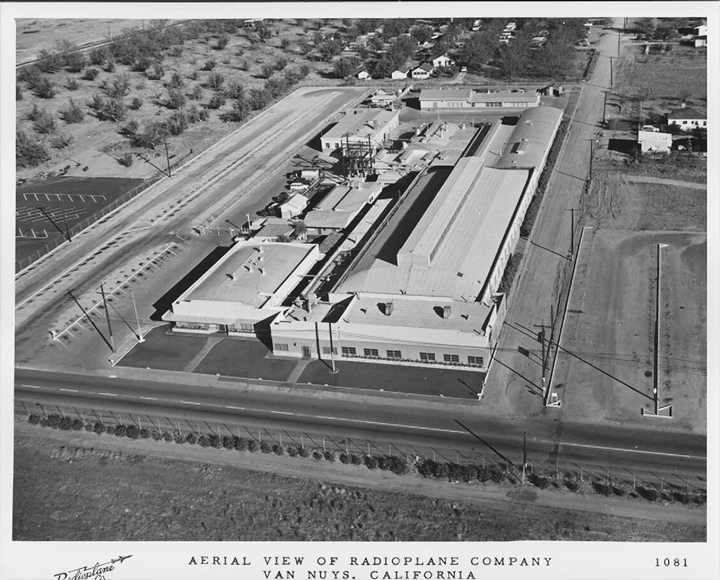
This 1950 photo shows the Radioplane Company
factory at 8000 Woodley Avenue in Van Nuys, CA. The company moved
one block north and to the opposite side of the street from its World
War Two location. Image courtesy of the University of Southern
California and the California Historical Society.
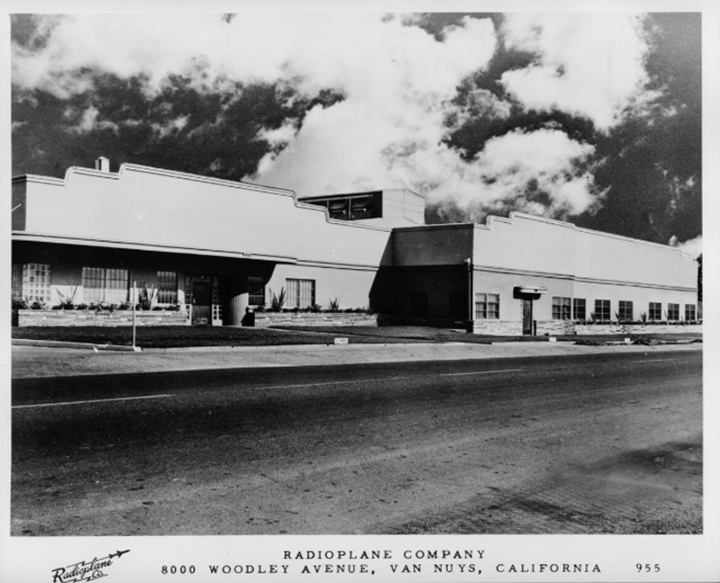
Image courtesy of the University of Southern
California and the California Historical Society.
The images below show the two former
Radioplane factory sites as they look today.
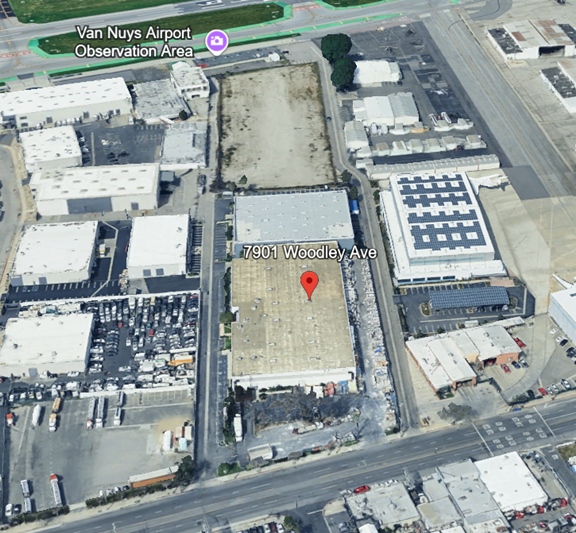
The Van Nuys airport is a lot more built up
than it was during World War Two. The former Radioplane factory
complex has been replaced by a large building. Image courtesy of Google Earth.
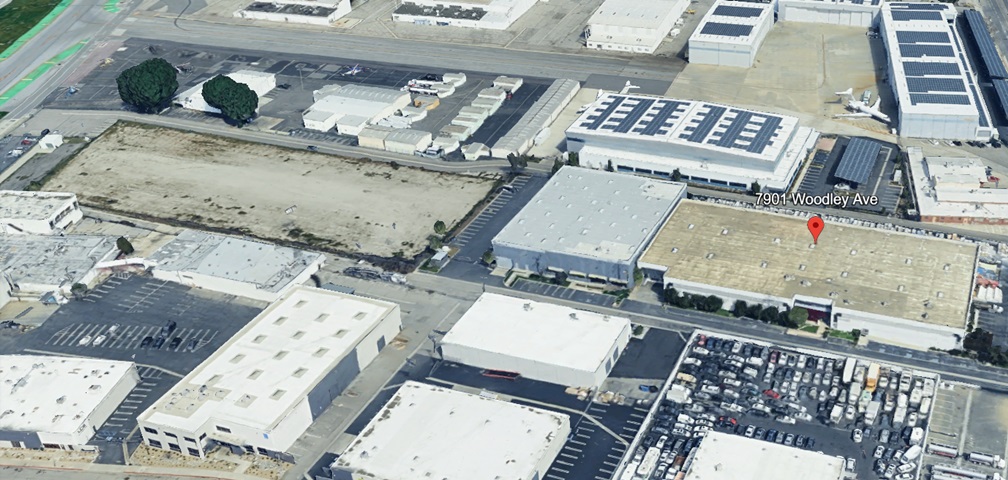
Image courtesy of Google Earth.
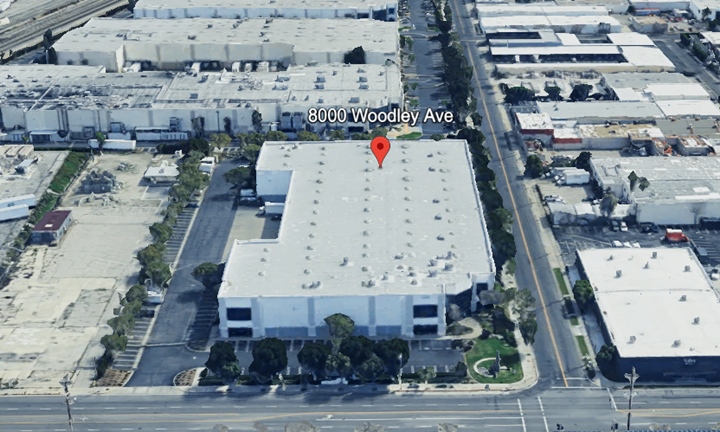
The former Radioplane plant at 8000 Woodley
Avenue has also been replaced. The whole area has become highly
industrialized and no longer has the houses and orchard of 1950.
Civilization has taken over. Image courtesy of Google Earth.
Radioplane World War Two Booklet and World War Two Photos
- This information is courtesy of Mr. Tom Fey.
|















































































